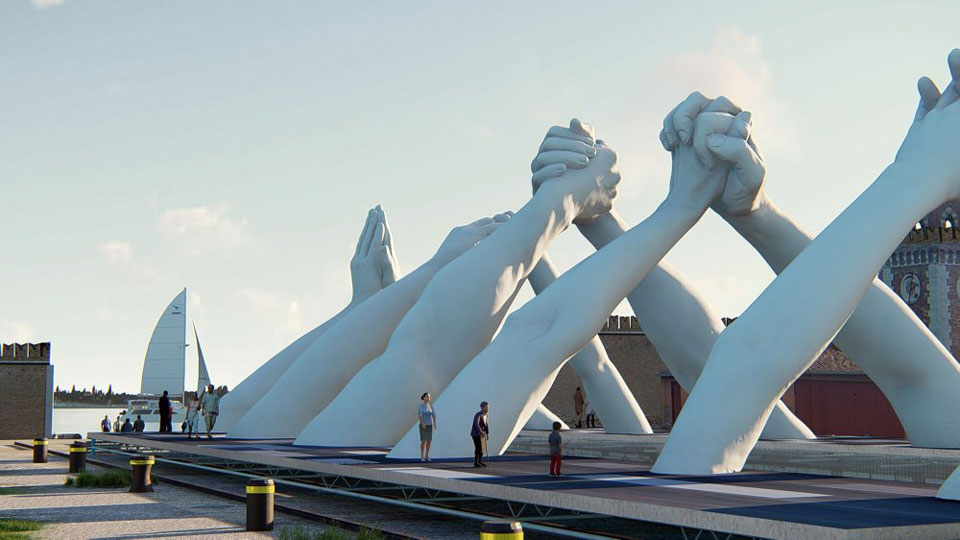
May You Live in Interesting Times is the title and organizing principle of this year’s Venice Biennale, the every-other-year festival of contemporary art, this year curated by Ralph Rogoff, head of the Hayward Gallery in London and now an officer in something called the Order of the British Empire, though many of the best pieces in the show were blows against the idea of a (white, masculinist, colonial) empire. An exception was the British Pavilion which made its colonial subjects (audience) stand in line for a half an hour in the Venetian heat and humidity to have their own private viewing, in the process seeming to affirm the idea of empire. This is the 58th version of the festival, which runs until November 24.

The phrase itself, employed across the political spectrum from as far left as Brecht and as far right as Hillary Clinton, has seemed to reference an ancient Chinese curse, though there is a bit of orientalism in that explanation since there is no trace of the phrase in Chinese. It all comes down to the meaning of the word “interesting.” The more astute artists in the exhibition translate “interesting” as horrible, blood-curdling, and perilous, while others seem to reaffirm Rogoff’s catalog description of the phrase as “complex.” These come dangerously close to reaffirming a virtual utopia or simply wallowing in the chaos that the combination of climate disaster, impending recession, nuclear war on earth and in space, and continual appropriation of more resources by the wealthiest has wrought. The catastrophic meaning of interesting seemed to prevail in Italy as yet another government collapsed during the exhibition (though the phoenix, if it rises from the ashes, will have a more progressive drift). In the face of this wanton destruction, the stock market went up.
Rogoff did a splendid job of organizing his curated part of the exhibition, often juxtaposing or combining elements that heightened their presentation. Art world breakout star of the exhibition Kaari Upson’s eerie full-scale dollhouse, which she had rampaged through by destroying the furniture and which displayed her video of herself in grotesque doll costume with blotchy smeared red lipstick, is paired with Mari Katayama’s images of herself as a Japanese doll. Katayama’s positioning herself as petite object of desire is belied by the fact that she has lost both her legs so that she appears in photos with the stubs or her prosthetic legs showing amid the eroticized stockings and accouterments of the trope of the Japanese human doll. Both do a splendid job of making us gasp at the image of the woman as toy for male desire.

Elsewhere Rula Halawani’s sodden black and white images of walls and enclosures built by Israel since 2000 in their sad bleakness suggest images of the earlier Berlin Wall. These link to Teresa Margolles’s stone wall with barbed wire and bullet holes depicting the enclosed structure in Ciudad Juárez, which has the highest murder rate in the world, with women disproportionate victims of the violence.
Both works, and walls, are much in abundance here, criticizing the global right-wing resurrection of borders, and are perhaps summed up by two more abstract but equally powerful installations: Shilpa Gupta’s large mechanical door with spikes on top that bangs shut and revolves from one side of a wall to another, slowly breaking down the wall in the process, the sound and the image stressing the violence of the border. Sun Yuan and Peng Yu’s giant robotic arm has been taught 32 different movements, all of which, though, end in the arm’s sweeping what looks like blood on the floor, perhaps the result of not only mechanical systems of walls and surveillance but also suggesting the blood that is the residue of the drive toward automation as more and more workers lose their jobs.
Women’s installations are the most powerful in the exhibition. These are exemplified by U.S. trans Latina artist Martine Gutierrez enacting a kind of post-colonial Cindy Sherman, where she places herself amid dummies that she has constructed framing black and white scenes of the exploitation and exoticization of non-white women. The most striking of these has her as a maid in what might be a Cuban Batista-era resort. Another shows her rising out of the water at the feet of a suited man with black polished shoes in a pose that eroticizes her but also, since she has a masterfully cunning look on her face, transforms this moment into a transgender transgressive seizing control of the situation.
My prize for best overall work goes to Alexandra Bircken’s stunning Escalation, a series of ladders reaching to the sky and intercrossing on the way up with hollowed-out black figures draped over the ladders or hanging from them like so many corpses, victims of the ever-increasing drive to get ahead: the human waste in the accelerated competition for ever-growing quarterly profits and increase in Gross Domestic Product.
The climate crisis was everywhere, and many of these presentations centered around either the questioning or the reaffirming of the Anthropocene, the melding of man and machine as the virtual world merges with our world. Christine and Margaret Wertheim’s intricate coral reefs constructed of yarn showed in their complexity how nature thwarted in the multitudinous shapes of the reefs the more rigid rationality and logic of Euclidean geometry which they diagrammed on a board next to their colorful concoctions. Even more to the point, Irish artist Jimmie Durham, whose body of work was honored in this year’s event, displayed the maimed but proud heads of animals tortured on the bodies of industrial pipes or electrical wiring in a way that emphasized the growing number of species that are becoming extinct as the race to exploit the world’s resources heats up and as Trump and the Pentagon are trying to claim Greenland’s mineral wealth as their own while the Amazon burns.

On the other side were the badly concocted 48 War Movies by Christian Marclay and Embracing the Dystopia by Ian Chang. The first, a compilation of 48 war films where, instead of being juxtaposed, are all obliterated as we can only see the outline of each and hear the screeching sounds of war. This is more The Hurt Locker’s emotional battlefield with no context than, say, Kubrick’s laying bare of the mechanisms of aggression in Full Metal Jacket. Dystopia assembles algorithms to create artificial creatures in environments that embrace both the destructive randomness of neoliberal capitalism and at the same time its extreme orderliness.
This year the curated exhibitions outshone the national pavilions in the Venice Gardens, the Guardini, but two especially strong works stood out. The first was Chile’s Hegemonic Museum, a truly remarkable work by Voluspa Jarpa that attempts to trace in four rooms histories of colonial expansion and exploitation. The first concentrates on the upside-down hanging of the DeWitts in Holland who challenged the place of the Dutch East India company and pushed for a more democratic state. This is followed by maquettes, tiny models of a vicious attack on women who demanded their rights in the Vienna uprising of 1848, part of a wave of revolutionary activity in that year. The next room is a taped opera whose verse is Western men singing “Blessed be the whiteness of my skin” and “I cannot own slaves and love them too” while a chorus of non-Western peoples, women and children answers these sentiments. A final room contains redacted official documents tracing the CIA’s involvement through operation Glaudio in not only interfering with but overturning the results of the 1948 Italian election, finishing with an illustrated three-dimensional rogues gallery of Western violence. An exemplary tour-de-force of an exhibit.
This was topped, though, by the outstanding country pavilion, my prize for best, and prized by the Biennale jury as well, Belgium’s Mondo Cane. It’s a dog’s world indeed, but that is not apparent as at first sight the exhibition looks to be a celebration of different aspects of the orderliness of bourgeois life in its idyllic mannequins of a knife sharpener, zither player, minister and town crier, each making their own sounds. The text accompanying the display tells another story as the knife sharpener (all these are based on actual characters) is at night a Sweeney Todd monster whose knife could cut off the legs of a horse. The town crier, whose thin mustache suggests Hitler, is actually crying an off-color, bigoted joke, and the musician is based on a character wanted for mass murders. Circling them are three jails which house the overtly violent, repugnant or rebellious members of the town such as the rat lady, a harbinger of death. The exhibit is an exceptional exposé of the violence that underlies all aspects of the repressed normalcy of capitalist life.

I will end on a critical note and a questioning of the meaning of reflection which the British Pavilion posed. Kathy Wilkes’s series of somnolent works suggesting a solemn and sepulcher-like female interiority were allowed to be viewed only by 15 visitors at a time, though the pavilion accommodates far more. That meant long lines in front of the exhibition in order to guarantee this privileged moment of a privatization of the experience. The work was in a way a standard YBA (Young British Artist) aging into more conservative maturity, but the idea that reflection must be done in private, that the group reflection the Biennale everywhere else encourages is somehow false or wrong, is one worth challenging.
The best exhibits this year were critical works that were meant to be shared and thought about in their public context, not fetishized as some wholly private revelation. We are long past the days when salvation in the actual dystopia the exhibit elsewhere so well describes can be achieved by individual contemplation. What May You Live in Interesting Times says implicitly in its overall impact is that the only way out of the impending doom humankind has created for itself is together. And perhaps together, we may yet transform “interesting” meaning terrifying into “interesting” meaning abundant.










